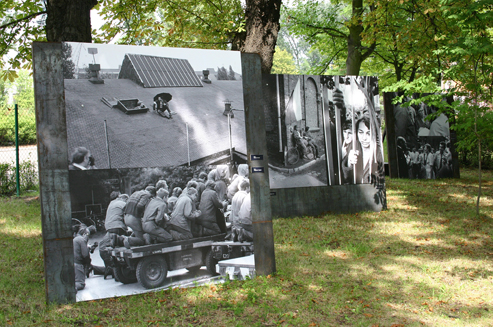On 14 August 1980 a strike broke out in the Gdańsk shipyard. A demand was given for the activists of the Free Trade Unions of the Coast to be reinstated to work, to erect a monument dedicated to the victims of the December 1970 protests, a guarantee not to repress the strikers and wage increases. Lech Walesa stood at the head of the Inter-Enterprise Strike Committee and the strikers presented 21 demands on two wooden boards. Above all they called for acceptance of free trade unions, independent from parties and employers. Today, the wooden boards with the handwritten demands of the strikers are entered on the UNESCO World Heritage List entitled “Memory of the World”.
In August 1980 crowds began to gather at gate No 2. The eyes of the entire world were focused on Gdańsk. On August 31, the Polish communist government approved the first independent trade union in the Communist Bloc as well as made a commitment to implement the remaining demands of the strikers. At once construction began on the Monument to the Fallen Shipyard Workers of 1970. It stood not far from Gate No 2, where the first victims of the anticommunist demonstration in December 1970 were killed. The soaring three crosses with powerful anchors are symbols of hope, commemorating the bloody sacrifices of victims of the strikes, but they are also a symbol of faith in a better tomorrow. This hope to live in a free country was also accompanied by demonstrators, who after establishment of martial law on 13 December 1981 protested against this decision in the streets of the city. The Monument to the Fallen Shipyard Workers on several occasions witnessed brutal suppression of protests by divisions of the Citizens’ Militia.
Next to it, in the basement of the Independent Self-governing Trade Union “Solidarity”, visitors can return to the facts and the atmosphere of the years 1956-1989 and to important events of that period for our country. A poor food shop from the 1970’s, documents testifying about uprisings against the Communist authority, and a symbolic prison cell from the period of totalitarianism illustrate Polish life up to the birth of the Solidarity movement. Through the recreated historical model of Gate No 2 visitors actually enter the striking world of August 1980. The original gate, as an object of particular importance for history and cultural heritage, received from the European Union the title of European Heritage Label. Here you can listen to authentic conversations of those striking, extracts from Holy Mass and the singing of shipyard workers against the backdrop of numerous slides, photos and symbolic blocks of styrofoam. The reconstructed Health and Safety Hall, in which negotiations were conducted with representatives of the shipyard and the government, are filled with such things as large format photographs showing the historical moment of signing the Gdańsk Agreement. The next stage of the exhibition recalls months full of hope, inextricably linked to “Solidarity”, and the return to the nightmare, this time associated with the introduction of martial law. “Time of change” is the title of the last part of this extraordinary exhibition reproducing the historic journey to freedom. At this final stage of the exhibition there is also a room devoted to the transition period in countries of Central and Eastern Europe.
After moving images, it’s time to take a break. In season you can check out the Subjective Bus Line. A historical bus called the “cucumber” takes visitors on a tour around the terrain of the shipyard, where former Gdańsk shipyard workers play the role of tour guides. During tours to shipyard areas that are usually closed on a daily basis you can not only see things such as Lech Walesa’s workshop, the former Health and Safety Hall of the Gdańsk Shipyard and the place where the leader of “Solidarity” jumped over the wall, but also objects related to the early history of the shipyard – buildings and ramps of the Imperial Shipyard as well as the U-boat Hall.
Before leaving the shipyard area you need to go to the Buffet pub, whose interior is decorated in the likeness of a “milk bar” from communist times. An additional attraction is the extending view of the cranes and the Wyspa Institute of Art adjacent to the bar. A point along the freedom route that you must see is the Zaspa estate. The large concrete slab residential buildings arising from the former airport runway, which during communist times were sad and grey, are today decorated with Poland’s largest collection of Monumental Paintings. As part of the Festival of Monumental Art 30 large paintings have already been painted.
Photo © the City Hall of Gdansk. The exhibition Road to Freedom – Solidarity Museum.
We invite everyone to participate in the 4th World Gdańsk Reunion



